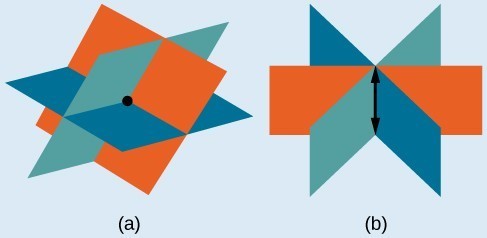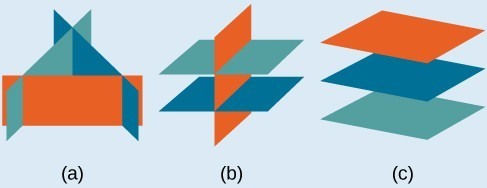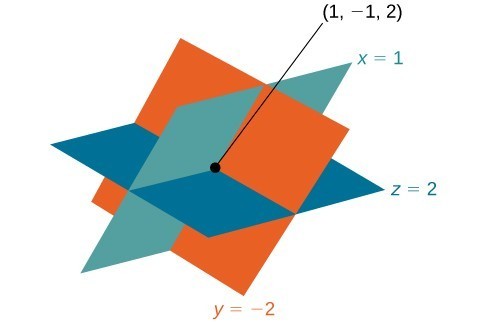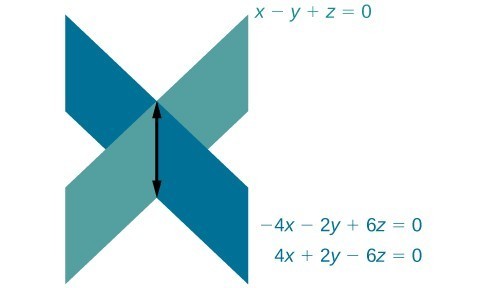Learning Outcomes
- Solve systems of three equations in three variables.
- Identify inconsistent systems of equations containing three variables.
- Express the solution of a system of dependent equations containing three variables using standard notations.
John received an inheritance of $12,000 that he divided into three parts and invested in three ways: in a money-market fund paying 3% annual interest; in municipal bonds paying 4% annual interest; and in mutual funds paying 7% annual interest. John invested $4,000 more in municipal funds than in municipal bonds. He earned $670 in interest the first year. How much did John invest in each type of fund?

(credit: “Elembis,” Wikimedia Commons)
Understanding the correct approach to setting up problems such as this one makes finding a solution a matter of following a pattern. We will solve this and similar problems involving three equations and three variables in this section. Doing so uses similar techniques as those used to solve systems of two equations in two variables. However, finding solutions to systems of three equations requires a bit more organization and a touch of visual gymnastics.
Solve Systems of Three Equations in Three Variables
In order to solve systems of equations in three variables, known as three-by-three systems, the primary goal is to eliminate one variable at a time to achieve back-substitution. A solution to a system of three equations in three variables [latex]\left(x,y,z\right),\text{}[/latex] is called an ordered triple.
To find a solution, we can perform the following operations:
- Interchange the order of any two equations.
- Multiply both sides of an equation by a nonzero constant.
- Add a nonzero multiple of one equation to another equation.
Graphically, the ordered triple defines the point that is the intersection of three planes in space. You can visualize such an intersection by imagining any corner in a rectangular room. A corner is defined by three planes: two adjoining walls and the floor (or ceiling). Any point where two walls and the floor meet represents the intersection of three planes.
A General Note: Number of Possible Solutions
The planes illustrate possible solution scenarios for three-by-three systems.
- Systems that have a single solution are those which, after elimination, result in a solution set consisting of an ordered triple [latex]\left\{\left(x,y,z\right)\right\}[/latex]. Graphically, the ordered triple defines a point that is the intersection of three planes in space.
- Systems that have an infinite number of solutions are those which, after elimination, result in an expression that is always true, such as [latex]0=0[/latex]. Graphically, an infinite number of solutions represents a line or coincident plane that serves as the intersection of three planes in space.
- Systems that have no solution are those that, after elimination, result in a statement that is a contradiction, such as [latex]3=0[/latex]. Graphically, a system with no solution is represented by three planes with no point in common.

(a)Three planes intersect at a single point, representing a three-by-three system with a single solution. (b) Three planes intersect in a line, representing a three-by-three system with infinite solutions.

Example: Determining Whether an Ordered Triple Is a Solution to a System
Determine whether the ordered triple [latex]\left(3,-2,1\right)[/latex] is a solution to the system.
[latex]\begin{gathered}x+y+z=2 \\ 6x - 4y+5z=31 \\ 5x+2y+2z=13 \end{gathered}[/latex]
How To: Given a linear system of three equations, solve for three unknowns.
- Pick any pair of equations and solve for one variable.
- Pick another pair of equations and solve for the same variable.
- You have created a system of two equations in two unknowns. Solve the resulting two-by-two system.
- Back-substitute known variables into any one of the original equations and solve for the missing variable.
Example: Solving a System of Three Equations in Three Variables by Elimination
Find a solution to the following system:
[latex]\begin{align}x - 2y+3z=9& &\text{(1)} \\ -x+3y-z=-6& &\text{(2)} \\ 2x - 5y+5z=17& &\text{(3)} \end{align}[/latex]
Try It
Solve the system of equations in three variables.
[latex]\begin{array}{l}2x+y - 2z=-1\hfill \\ 3x - 3y-z=5\hfill \\ x - 2y+3z=6\hfill \end{array}[/latex]
In the following video, you will see a visual representation of the three possible outcomes for solutions to a system of equations in three variables. There is also a worked example of solving a system using elimination.
Example: Solving a Real-World Problem Using a System of Three Equations in Three Variables
In the problem posed at the beginning of the section, John invested his inheritance of $12,000 in three different funds: part in a money-market fund paying 3% interest annually; part in municipal bonds paying 4% annually; and the rest in mutual funds paying 7% annually. John invested $4,000 more in mutual funds than he invested in municipal bonds. The total interest earned in one year was $670. How much did he invest in each type of fund?
Try It
Classify Solutions to Systems in Three Variables
Just as with systems of equations in two variables, we may come across an inconsistent system of equations in three variables, which means that it does not have a solution that satisfies all three equations. The equations could represent three parallel planes, two parallel planes and one intersecting plane, or three planes that intersect the other two but not at the same location. The process of elimination will result in a false statement, such as [latex]3=7[/latex] or some other contradiction.
Example: Solving an Inconsistent System of Three Equations in Three Variables
Solve the following system.
[latex]\begin{align}x - 3y+z=4 && \left(1\right) \\ -x+2y - 5z=3 && \left(2\right) \\ 5x - 13y+13z=8 && \left(3\right) \end{align}[/latex]
Try It
Solve the system of three equations in three variables.
[latex]\begin{array}{l}\text{ }x+y+z=2\hfill \\ \text{ }y - 3z=1\hfill \\ 2x+y+5z=0\hfill \end{array}[/latex]
Expressing the Solution of a System of Dependent Equations Containing Three Variables
We know from working with systems of equations in two variables that a dependent system of equations has an infinite number of solutions. The same is true for dependent systems of equations in three variables. An infinite number of solutions can result from several situations. The three planes could be the same, so that a solution to one equation will be the solution to the other two equations. All three equations could be different but they intersect on a line, which has infinite solutions. Or two of the equations could be the same and intersect the third on a line.
Example: Finding the Solution to a Dependent System of Equations
Find the solution to the given system of three equations in three variables.
[latex]\begin{align}2x+y - 3z=0 && \left(1\right)\\ 4x+2y - 6z=0 && \left(2\right)\\ x-y+z=0 && \left(3\right)\end{align}[/latex]
Q & A
Does the generic solution to a dependent system always have to be written in terms of [latex]x?[/latex]
No, you can write the generic solution in terms of any of the variables, but it is common to write it in terms of [latex]x[/latex] and if needed [latex]x[/latex] and [latex]y[/latex].
Try It
Solve the following system.
[latex]\begin{gathered}x+y+z=7 \\ 3x - 2y-z=4 \\ x+6y+5z=24 \end{gathered}[/latex]
Key Concepts
- A solution set is an ordered triple [latex]\left\{\left(x,y,z\right)\right\}[/latex] that represents the intersection of three planes in space.
- A system of three equations in three variables can be solved by using a series of steps that forces a variable to be eliminated. The steps include interchanging the order of equations, multiplying both sides of an equation by a nonzero constant, and adding a nonzero multiple of one equation to another equation.
- Systems of three equations in three variables are useful for solving many different types of real-world problems.
- A system of equations in three variables is inconsistent if no solution exists. After performing elimination operations, the result is a contradiction.
- Systems of equations in three variables that are inconsistent could result from three parallel planes, two parallel planes and one intersecting plane, or three planes that intersect the other two but not at the same location.
- A system of equations in three variables is dependent if it has an infinite number of solutions. After performing elimination operations, the result is an identity.
- Systems of equations in three variables that are dependent could result from three identical planes, three planes intersecting at a line, or two identical planes that intersect the third on a line.
Glossary
solution set the set of all ordered pairs or triples that satisfy all equations in a system of equations
Candela Citations
- Revision and Adaptation. Provided by: Lumen Learning. License: CC BY: Attribution
- College Algebra. Authored by: Abramson, Jay et al.. Provided by: OpenStax. Located at: http://cnx.org/contents/9b08c294-057f-4201-9f48-5d6ad992740d@5.2. License: CC BY: Attribution. License Terms: Download for free at http://cnx.org/contents/9b08c294-057f-4201-9f48-5d6ad992740d@5.2
- Question ID 23765, 29695. Authored by: Roy Shahbazian. License: CC BY: Attribution. License Terms: IMathAS Community License CC-BY + GPL
- Systems of Equations in Three Variables: Part 1 of 2. Authored by: James Sousa (Mathispower4u.com) . Located at: https://youtu.be/wIE8KSpb-E8. License: CC BY: Attribution
- Precalculus. Authored by: OpenStax College. Provided by: OpenStax. Located at: http://cnx.org/contents/fd53eae1-fa23-47c7-bb1b-972349835c3c@5.175:1/Preface. License: CC BY: Attribution

